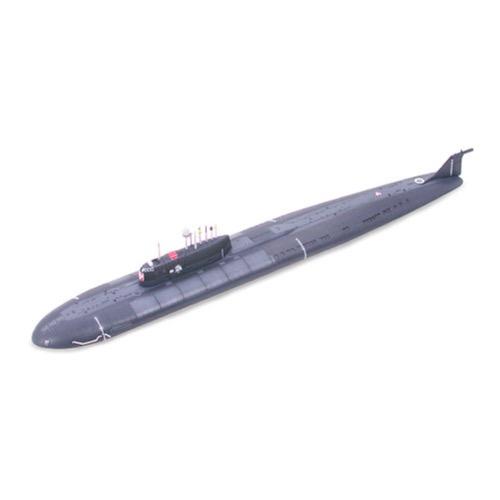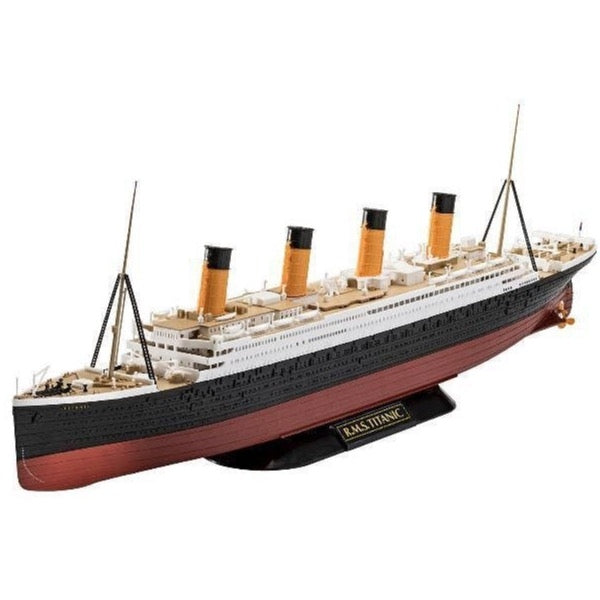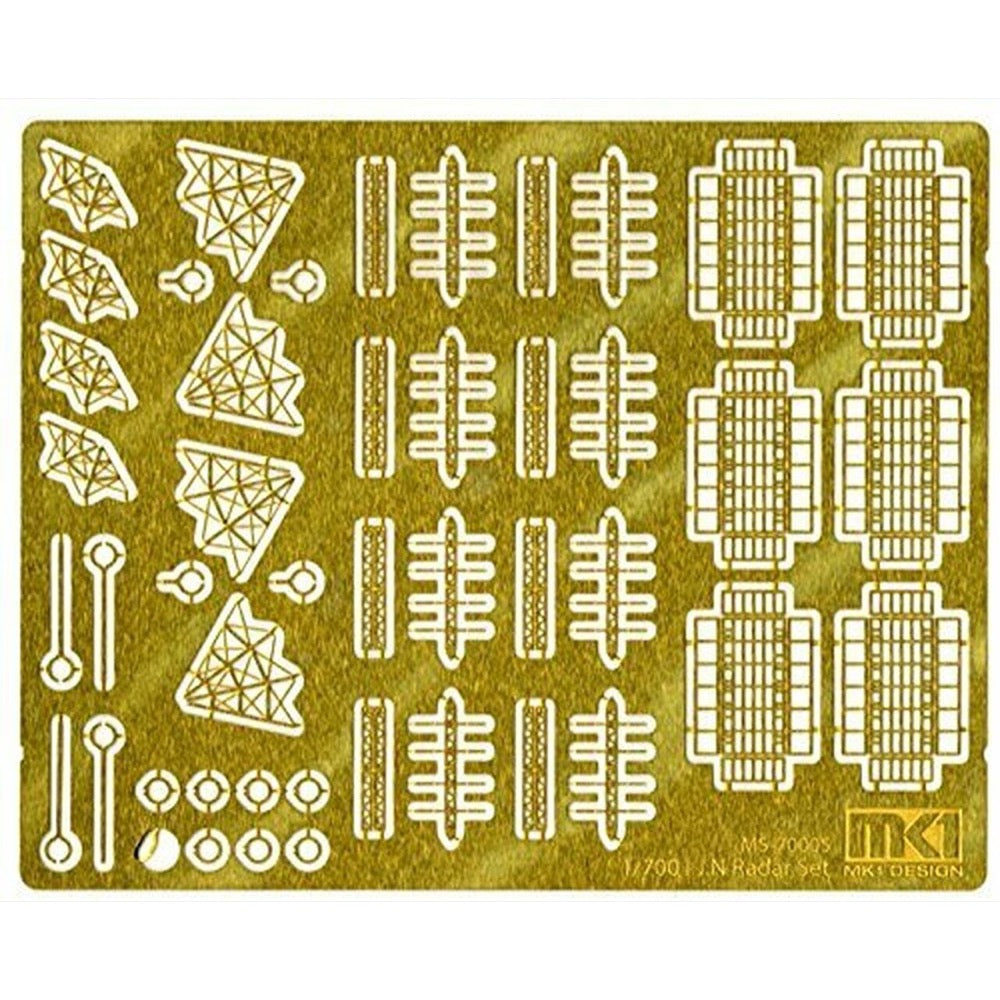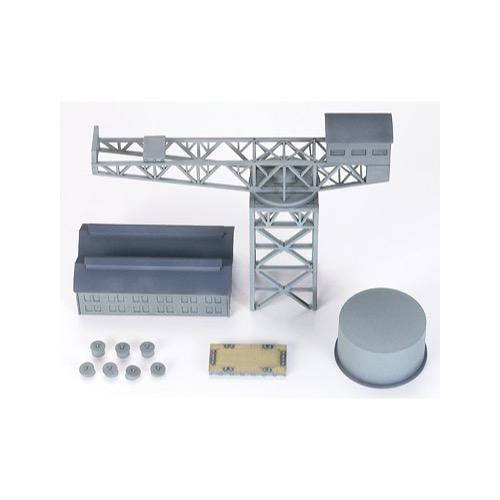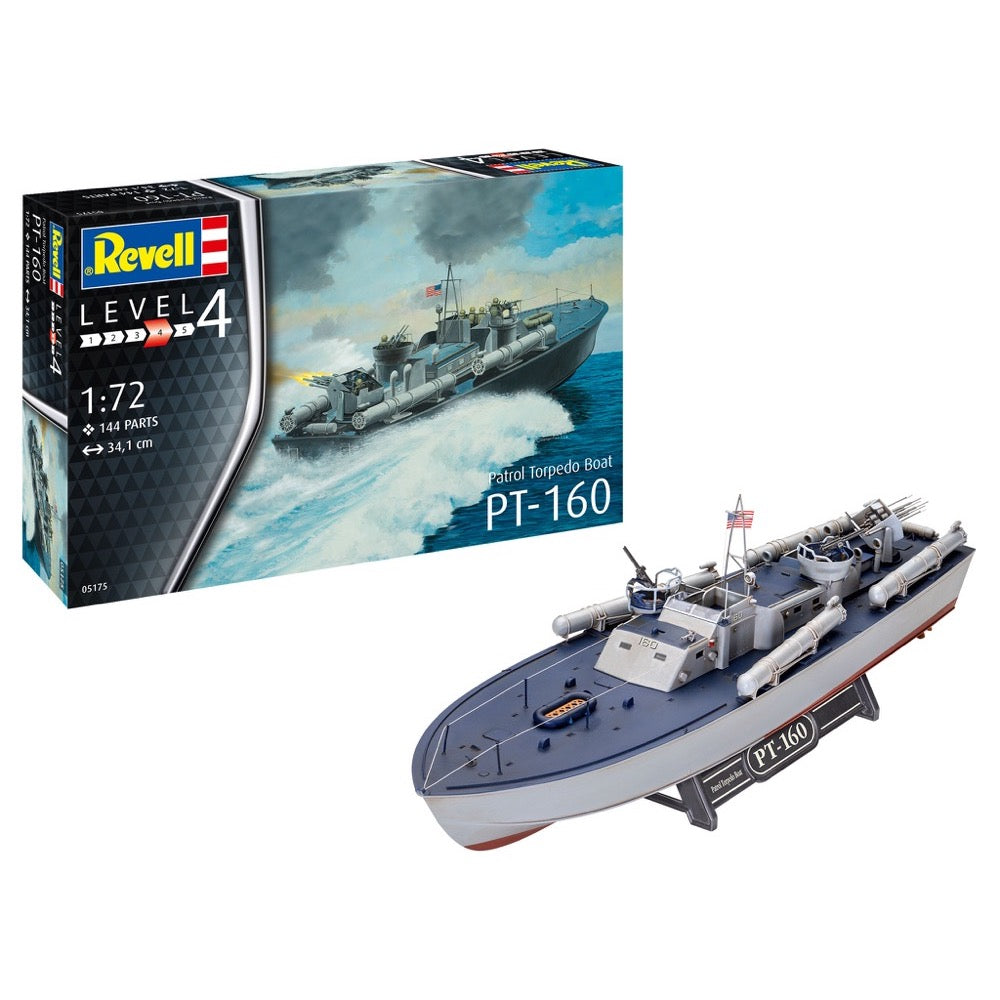
Revell 05175 1/72 Patrol Torpedo Boat PT-559 / PT-160
22.00
$
<p>In WWII, the US Navy used type PT patrol boats to survey the Pacific island region, marked by reefs and atolls. Some crews customised their boats, decorating them with the outrageous "nose arts" typical of bombers and fighter jets at the time.</p>
<h3>Features</h3>
<ul>
<li>
<p>Two-part hull</p>
</li>
<li>
<p>Interiors</p>
</li>
<li>
<p>Decal with "nose art"</p>
</li>
</ul>
<h3>Specifications</h3>
<ul>
<li>
<p>Scale:1:72</p>
</li>
<li>
<p>Age:12+</p>
</li>
<li>
<p>Number of parts:146</p>
</li>
<li>
<p>Length:341 mm</p>
</li>
<li>
<p>Width:107 mm</p>
</li>
<li>
<p>Height:120 mm</p>
</li>
</ul>
<h3>Scope of delivery</h3>
<ul>
<li>
<p>Plastic model kit (non-assembled), Illustraded, multilingual assembly instructions, Decal set</p>
</li>
</ul>
<p> </p>
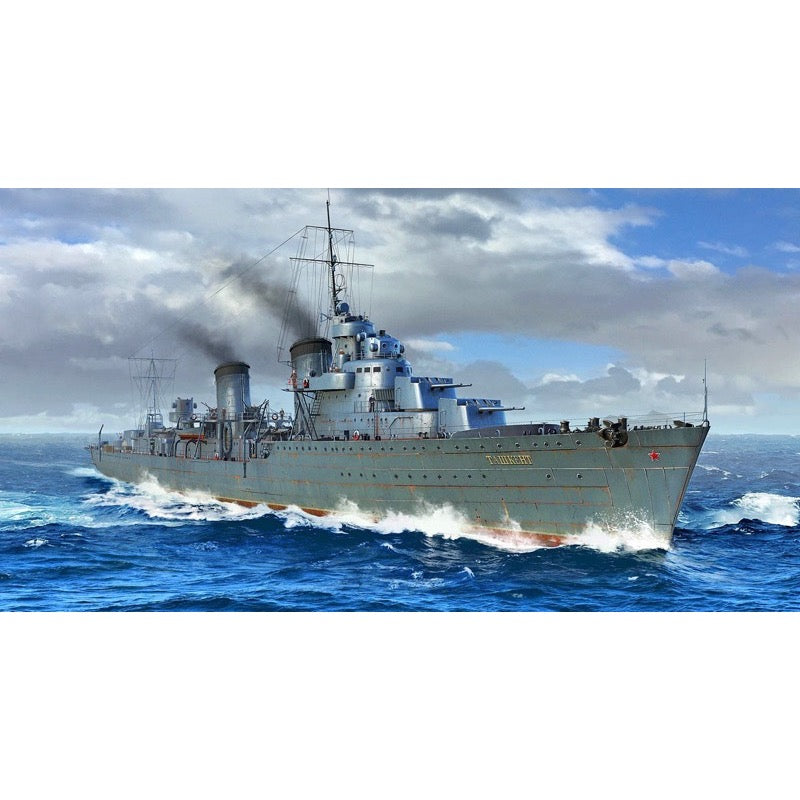
Trumpeter 05357 1/350 Russian Destroyer Taszkient 1942
39.00
$
<p>"Tashkent" destroyer leaderJanuary 11, 1935 Started construction in Italy,November 28, 1937Into the water,October 22, 1939The Soviet Union accepted into service. The design of the "Tashkent" was unusually avant-garde at the time. It was one of the few large ships capable of speeds exceeding 40 knots during World War II. After the transformation in 1942, the firepower was even upgraded to the level of light cruisers.</p>
<p>During World War II, her main mission was to serve as a transport ship for personnel and materials. Among the Soviet ships that transported supplies to Sevastopol , the "Tashkent" was quite legendary. Even the Germans knew its name. It transported supplies to the besieged Soviet army dozens of times before being hit by the Luftwaffe. In more than 90 air strikes, the Germans dropped more than 400 bombs and 10 torpedoes .</p>
<p>After being withdrawn to the Novorossiysk naval base, the "Tashkent" was completely blown up on the berth in an air raid on July 2. It was salvaged in 1944 and demolished in 1945 because it had no repair value.</p>
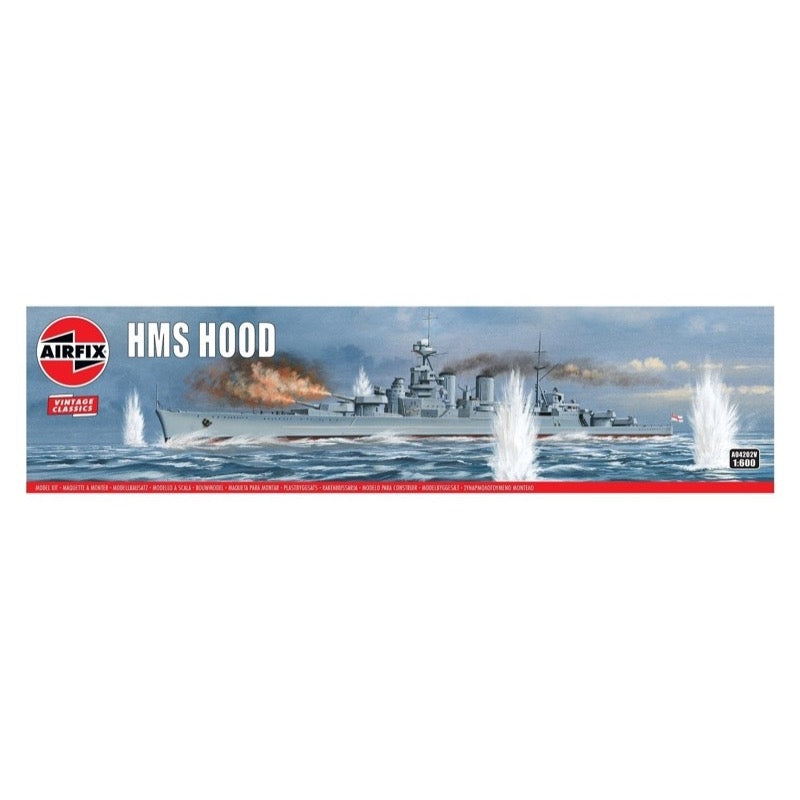
Airfix A04202V 1/600 Vintage Classics HMS Hood
18.00
$
<p>The largest warship in the world when launched in 1918. She was the pride of the Royal Navy on sailing to intercept the Bismarck in May 1941. After making contact with the German battleship she, with HMS Prince of Wales opened fire. The Bismarck returned fire and with her 5th salvo hit the Hood a fatal blow and she sunk within two minutes. Only three crew from her total of 1,500 survived.</p>
<h3>Specification</h3>
<ul>
<li>1:600 Scale</li>
<li>Parts Included: 131</li>
<li>Skill Level: 3</li>
<li>Scheme Options: 1</li>
</ul>
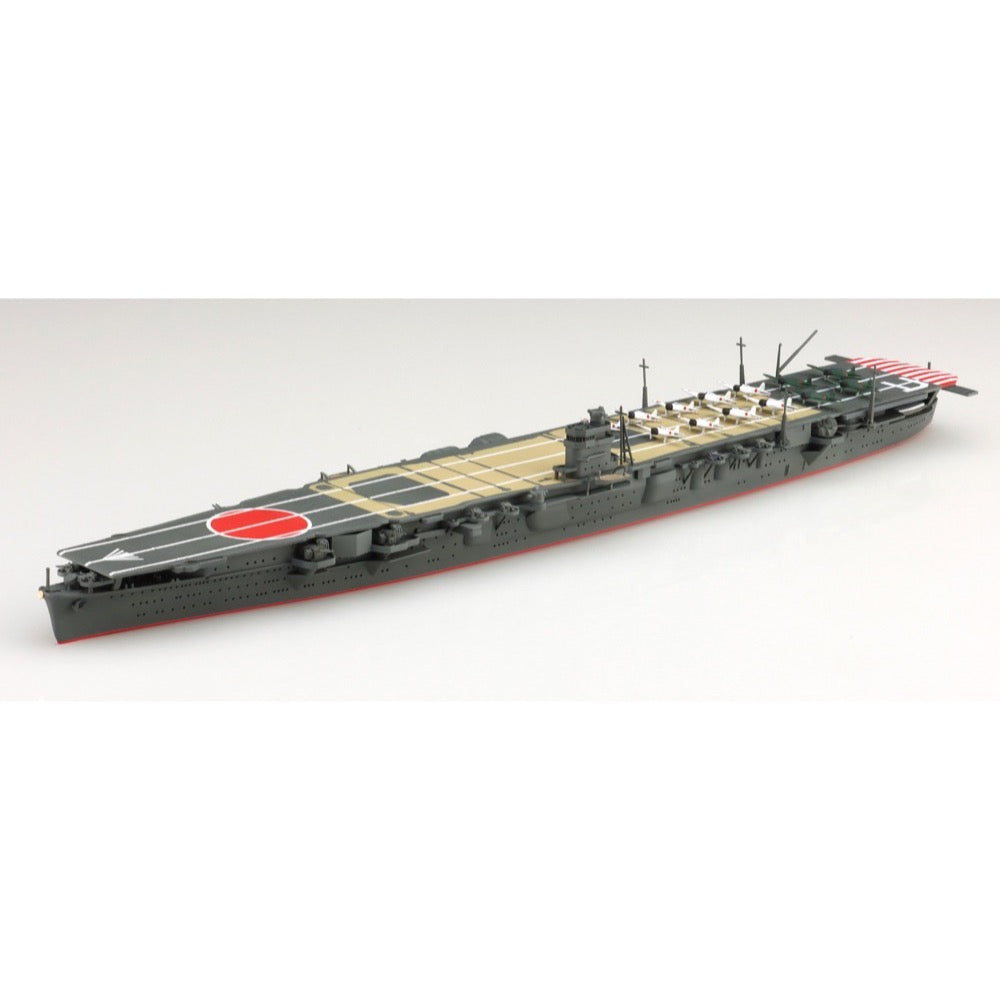
Aoshima 06655 1/700 Japanese Navy Aircraft Carrier Hiryu
23.00
$
<p>The aircraft carriers Hiryu and Soryu were built under the London Disarmament Treaty in 1930, and were part of the 1933 disarmament expansion plan. Soryu was completed first, but further improvements were made to Soryu, and Hiryu was completed at the Yokosuka Naval Arsenal on July 5, 1939. Based on the operational experience of the previously completed Soryu and Kaga, it was decided that Hiryu would have the bridge installed in the center of the hull so as not to interfere with the aircraft taking off; the chimney on the starboard side was placed on the port side to be on top of the ship. Although the arrangement was favorite in terms of weight distribution, it was discovered that the air currents generated from the bridge had an adverse effect on carrier-based aircraft landing on the ship. Therefore, aircraft carriers built after this time had a bridge on the starboard side; Hiryu and Akagi were the only ones with a bridge on the port side, giving them a unique appearance. She became an extremely successful and powerful aircraft carrier, with features such as high-speed performance exceeding 34 knots, improved hull strength, improved defense capabilities, and a carrying capacity of 57 aircraft.</p>
<p>Hiryu's military history includes support for the invasion of the continent in 1945, the surprise attack on Pearl Harbor on Dec. 8, 1945, the capture of Wake Island, the sweep of Java and New Guinea, and the Indian Ocean operations. In the battle, the bomb squad she carried had an amazing hit rate, sinking the British aircraft carrier Hermes and the heavy cruiser Cornwall. At the end of May 1944, Hiryu left Japan to participate in the fateful Battle of Midway. Early in the morning on June 5, 1945, Captain Tomonaga of the Hiryu judged that the first attack was insufficient and requested a land attack, and the equipment of the Air Force that was on the other ships, waiting on the mother ship, was transferred to land. This led to a hectic situation in which they had to change to attack equipment. In addition, a reconnaissance aircraft reported the discovery of an enemy task force, and in an unusual situation where the equipment of the Air Force was changed to ship attack equipment again, a U.S. Navy bomb squadron dive-bombed the Akagi and Kaga, and all three of Soryu's ships burst into flames in an instant. Hiryu was the only ship left unscathed, so she launched an attack on the American aircraft carrier Yorktown, rendering Yorktown unable to navigate. However, Hiryu was bombed by the attack force launched from the remaining two aircraft carriers, and out of four bomb hits, two close hits caused her to burst into flames and become unable to navigate. It was assumed that the destroyers Arashi and Nowaki were torpedoed, and they were thought to have sunk, but they were later found drifting aboard the Hosho. The plane was spotted and they hurriedly went to rescue them, but by the time they arrived at the scene, they were gone.</p>
<p>Aoshima brings us a 1/700-scale waterline model kit of the Hiryu, known for her success in the early days of the Pacific War and her bravery at the Battle of Midway. The parts structure is simple, easy to assemble, and accurately reproduced. In addition to various equipment such as regular machine guns and high-angle guns, newly designed equipment has been added, including an anti-aircraft firearm with a smoke shield on the starboard side where the chimney is located. Many parts are slide-molded for density and precision; in addition to armaments such as destroyer main guns and machine guns, carrier-based aircraft and other equipment have been updated. The following parts are updated with new molds:</p>
<ul>
<li>Type 94 shooting device</li>
<li>Type 89 12.7cm twin high-angle gun</li>
<li>Type 89 12.7cm twin high-angle gun with smoke shield</li>
<li>Type 96 25mm twin machine gun</li>
<li>Type 96 25mm triple machine gun</li>
<li>12m fire launch</li>
<li>12m fire boat</li>
<li>Radial davit</li>
<li>9m cutter</li>
<li>Chrysanthemum emblem</li>
<li>Anchor</li>
</ul>

Aoshima A000471 1/700 J.M.S.D.F. Aegis Escort Ship Atago
23.00
$
<p>Detailed waterline kit of the Atago includes a P3C, SH-60, F2, and land-based rocket with launch pad.</p>
<p>The Atago class of guided-missile destroyers in the Japan Maritime Self-Defense Force is a modified version of the Kongō class equipped with the Aegis Combat System.</p>
<p>The design is fundamentally an improved and scaled-up version of the Kongō-class destroyers with a 4-meter extension of the hull. Just as the Kongō class, the superstructure is larger than aboard the American counterparts, Arleigh Burke-class Flight IIA.</p>
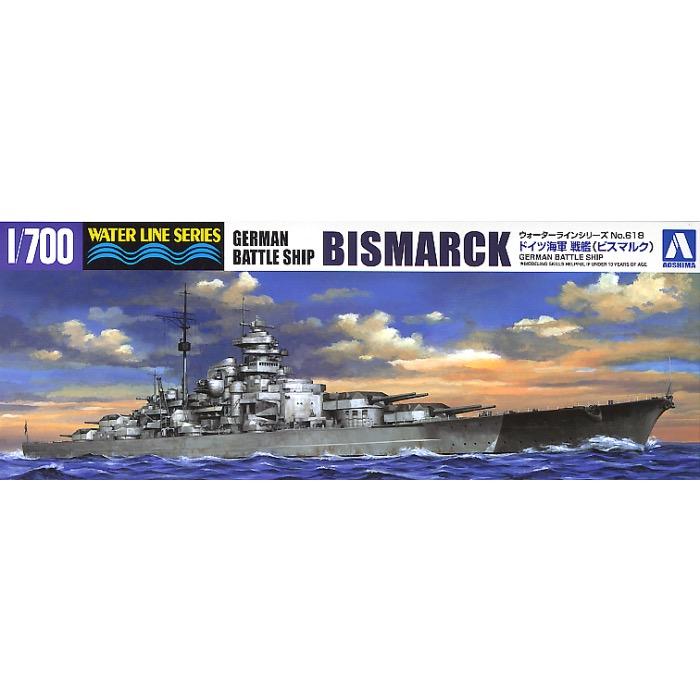
Aoshima A004259 1/700 German Battleship Bismarck
18.00
$
<p>Bismarck was a German battleship, the keel of which was laid in 1936 and launched in February 1939. The battleship entered the rope service in the German Navy (German Kriegsmarine) in August 1940. The ship was 251 meters long, 36 meters wide, and had a full displacement of 53,000 tons. Bismarck's top speed was around 29-30 knots. The main armament was 8 380 mm guns in four twin turrets, and the secondary armament included: 12 150 mm guns or 16 105 mm guns.</p>
<p>The Bismarck was the first ship of the type with the same name - the Bismarck. It was ordered to replace in line the old battleship Hannover, completely obsolete in the 1930s. At the time of launch, Bismarck was the largest German ship and the largest European battleship. It had good armor, and its main or secondary armament was inferior to its counterparts on British ships. He made his maiden voyage in September 1940, when he was ferry to Gdynia, which was to be his home port. Bismarck's combat trail during World War II was very short. Bismarck set out on its first combat voyage on May 19, 1941 - it was supposed to perform cruising operations in the Atlantic and attack primarily Allied convoys. In carrying out this plan, Bismarck, with the accompanying heavy cruiser Prinz Eugen, was already crossing the Danish Strait a few days later. On May 24, a battle took place in this strait between the German team and British ships, as a result of which the battlecruiser HMS Hood was sunk and Bismarck itself was badly damaged. After this battle, significant Royal Navy forces - including the Polish destroyer ORP Piorun - were directed against Bismarck, which the German ship tracked down and sent to the bottom on May 27, 1941. It is worth noting that there is a probable hypothesis assuming that the battleship Bismarck was self-sunk by the crew in connection with the damage sustained in combat on May 27, which made it impossible to return to the base on its own.</p>
<p>One of the most famous battleships of WWII, Germany's Bismarck reached nearly legendary status in the early days of the war, punctuated by the spectacular sinking of the British battlecruiser Hood. The Bismarck herself was then sunk shortly afterward by the combined might of British Naval forces, but not before having established a myth-like legacy.</p>
<p>Aoshima's 1/700 Bismarck is a re-release of its excellent waterline Bismarck kit, this time without the Z-class destroyer included in the previous releases. The molding is sharp and the detail is fine.</p>
<p>This is an injection-plastic ship model kit.</p>
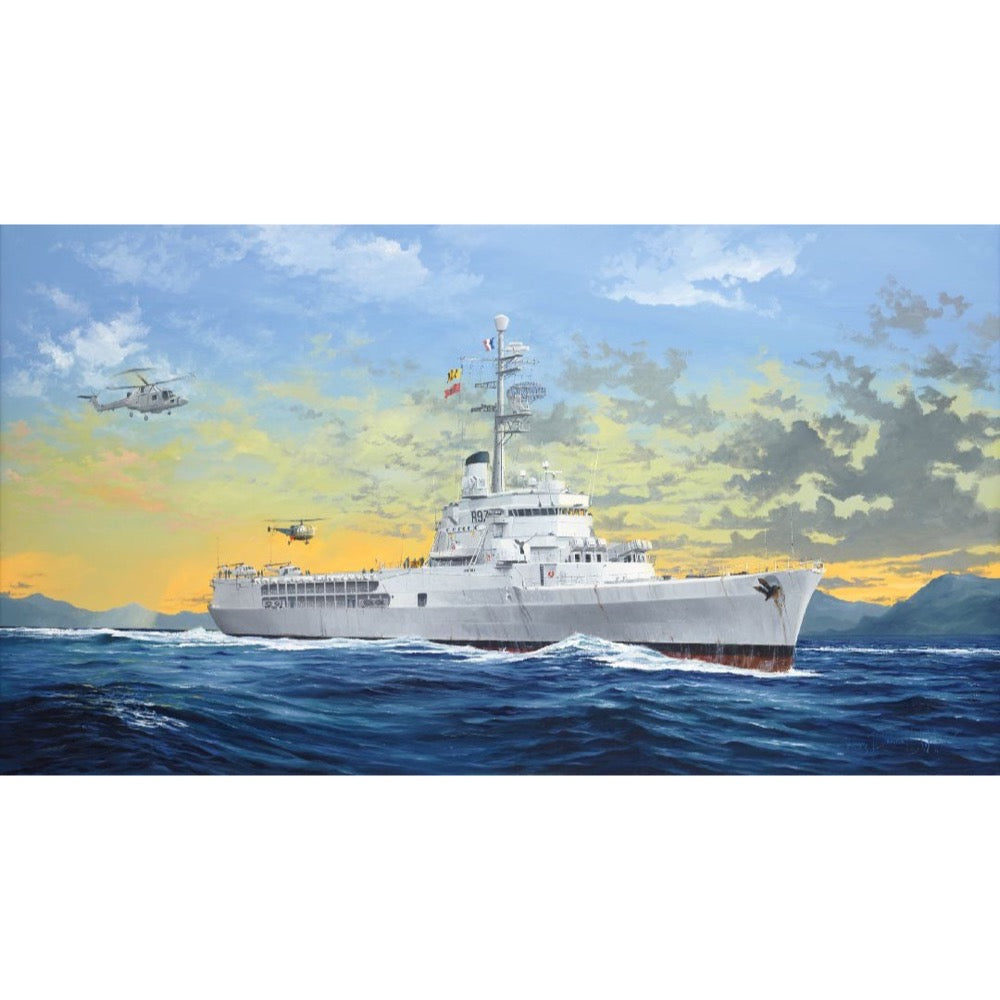
Trumpeter 05635 1/350 French Jeanne D Arc 2008
47.00
$
<p>France Jeanne d'Arc helicopter carrier formerly known as Resolution , after the French heroine in history - Joan of Arc named. The ship 7 July 1960 construction started, September 30, 1961 launched, June 30, 1964 in service.</p>
<p>Jeanne d'Arc was widely used, usually used as a training ship, wartime little modification, it can be used as amphibious assault ship, helicopter carrier or troop transport ship. When making troop transport ships can carry a 700-man battalion landing their equipment.</p>
<p>The ship junction 182 meters long, 24 meters wide ship, draft of 7.3 meters; gear power unit 2 turbine axis, 40,000 horsepower; maximum speed of 26.5; 15 when the speed, endurance of about 10,000 kilometers or more. Only one ship helicopter platform, can load 8 helicopter; the ship late armament systems installed feature four 100 mm gun, six "flying fish" MM38 ship missile launchers. Jeanne d'Arc aircraft carrier in 2000 carried out modernization, removed aft 100 mm anti-aircraft artillery.</p>
<h3>Features</h3>
<ul>
<li>Detailed Hull is a one piece part</li>
<li>Detailed decks</li>
<li>Extensive photo-etched details included</li>
<li>Helicopter includes: HAS-3 *2, ALOUETTE *2 , GAZELLE *2,EH101 *2</li>
</ul>



